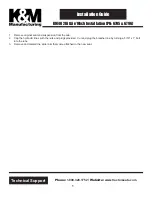
4
DESCRIPTION
Traverse aluminium roof racks WING are designed to be mounted on approved longitudinal roof rails and are suitable for most vehicles fi tted with these
rails. These roof racks are used to transport items and loads on the roof of the vehicle. On the top of the installed traverse roof racks it is possible to mount
roof boxes, ski and bike carriers, etc. The traverse roof racks are fi tted with safety locks to prevent theft.
IMPORTANT SAFEGUARD
• These roof racks are suitable for most vehicles with longitudinal rails.
• To prevent the vehicles roof from being damaged, it
is advisable for 2 people to assemble and disassemble
the roof racks.
• The distance between the two racks must be 700 mm
(unless different instructions are given by the vehicle
manufacturer).
• Ensure the roof racks do not project past the sides
of the vehicle when they are fi tted. Trim down bars if
necessary with appropriate cutting tools.
• The load must be evenly distributed with the lowest
possible centre of gravity.
• Before setting out and periodically during a trip, check to make sure the roof racks are still fi rmly fastened in place. Make sure that all the fi xing devices
are locked correctly and that the straps that bind the load are tightened and the load has not shifted.
• Where surfboards are carried (or similar items which may produce lifting forces), they must not be carried side-by-side, but stacked one on top
of the other. All surfboards and similar items must be secured independently to the front and rear of the vehicle using straps or other methods which are
capable of withstanding the lifting forces.
• Equipment must be maintained in good working order.
• The handling characteristics of a vehicle will change when roof racks are fi tted and especially when it is loaded (in particular, crosswind sensitivity,
handling on bends, and braking). Driving techniques should be altered to allow for these changes such as, reducing speed, (especially on bends)
and allowing for longer braking distances.
• If long objects are transported, the ends should also be fi xed to the vehicles’ tow points.
INSTRUCTION
1.
The roof racks have been supplied with 4 lockable clamps.
The 2 lockable clamps marked A contain an allen key which is used to secure the roof racks to the raised roof rails on your vehicle.
• To access the allen key, turn the key clockwise.
• Pull out the key pad, you will then see the allen key.
INSTALLATION GUIDE
EN
• CAUTION: Do not use elastic straps to tie down load. lt is important to tie the load safely with load applicable non-elastic tie-downs.
• The load must not be heavier than the bearing capacity of the roof as indicated by the vehicle manufacturer.
• The tolerated bearing capacity comprises the weight of the actual roof racks at approximately 4 kg, plus the additional load.
• The bearing capacity of the roof racks (pair) is 90 kg.
• The manufacturer declines all liability for damage deriving from the vehicle having been driven at a high speed, from having been driven
incorrectly, or from the roof rack or load having been poorly positioned, fi xed or fastened.
• Do not exceed the recommended maximum speed of 110 kmph with load applied to roof racks.
• Not suitable for vehicles where the roof rails are fl ush with the vehicles roof surface.


























